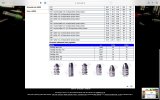afmelo
AH member
- Joined
- May 19, 2023
- Messages
- 25
- Reaction score
- 28
- Location
- Portugal
- Hunted
- Angola, Belgium, Sweden, Portugal
Yes, the numbers for that powder also look good but as the speed of the powder goes up, so does the potential for small errors in loading and small increases of powder causing geometric, thus unexpected spikes in pressure. Both N110 and N105 are in the burn speed zone that may work in the Snider. One thing I do when looking at this type data is to construct a simple pressure curve. Then at the point of interest of the intercept between charge and pressure on the curve, draw a tangent line at that point. The slope of the tangent line at that point instantly gives an intuitive, visual feedback of the geometric relationship between the charge and pressure. IMO and in my thought process, the steeper that slope, the greater the potential for an "unplanned" excursion into a zone of extreme pressure.
Another thing that may play a role in powder suitability for any particular application is the chemical nature the powder. I think generally, no matter the burn speed, double base powders inherently carry greater stored chemical energy than single base powders.
Pic is of a chart by Vihtavuori showing relative burn speeds of various powders. More data is always better. This copy is dog-eared for a reason
View attachment 535525
Yes, single and double base powders really have a different behavior - I use a lot N140 and N540 in my 6Norma BR benchrest loads. They are very different in reaction to weather conditions, namely heat and humidity. After a few years I prefer single base powders - more stability and less barrel heating!
I assume the same should happen with these old guns loads, although my experience is limited here.
I have been learning a lot with you on the Snider. But my most recent "baby" is a Westley Richards monkey tail... One of 8.000 carbines ordered by Portugal in 1866, delivered in 1867. It is in superb shape and ready to dance... But in this last case nobody seems to risk a smokeless load! In your opinion is there a way to use a lite load of smokeless in this gun?



